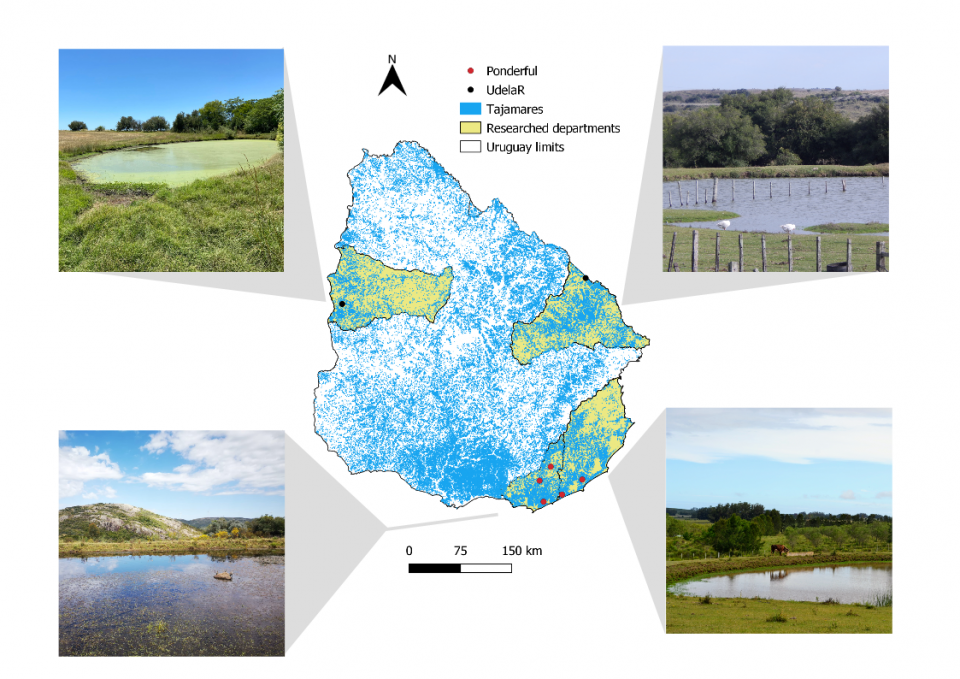
Bioclimatic zone: Temperate grasslands, humid subtropical climate.
Dominant land use: Cattle grazing (on natural grassland or pastures) and agriculture.
Tajamares: Over 170000 «tajamares de aguada» (meant to water cattle) by 2021 (according to the national spatial information infrastructure - IDE).
Density: The densest region is Canelones with over 4 tajamares per km2, and the least dense region is Rio Negro with 0.3 tajamares per km2.
Surface area: The most frequent surface area is between 90 m2 and 0.5 ha, but «tajamares de aguada» can reach up to 4 ha.
Water column: Usually from 0.5 to 3m. (Technical guidelines from the Ministry of Agriculture, Cattle and Fisheries (MGAP) recommend water columns higher than 2m).
In Uruguay, rural artificial ponds (tajamares) are primarily constructed to support cattle production and secondarily for the irrigation of crops or other purposes, mostly since the early 2000s. Studies on their environmental impact are extremely scarce and incipient.
Construction of tajamares de aguada has been promoted for decades by different administrations, either through technical assistance or loans to farmers at the national and municipal levels. Due to their small area, tajamares do not require environmental authorization for construction. In principle, all tajamares, regardless of size, should be registered and built according to specific technical guidelines to secure water volume. However, this is rarely done due to associated costs, and fines are almost never applied. Management is not monitored, leaving it up to the farmers to implement measures they deem appropriate, including in those ponds constructed inside Protected Areas.
To secure the provision of the above mentioned NBS, their design and management should incorporate ecological guidelines (i.e. complete and diverse native vegetation as buffer, avoidance of exotic species, management of nuisance vegetation).
Tajamares could exert a positive or negative impact on the environment, depending on their design, construction, and management. Properly managed ponds have the potential to alleviate local biodiversity and wetland losses. Monitoring and management practices to safeguard water quality and biodiversity are increasingly needed in light of the growing challenges posed by eutrophication, climate variability and climate change.
The potential benefits they offer are aquatic biodiversity, regulation of freshwater quantity, location and timing, food and feed (mainly to cattle), regulation of freshwater quality, habitat creation and maintenance, and regulation of hazards and extreme events.
- Developing climate change adaptation; improving risk management and resilience
- Flood peak reduction
- Increase infiltration / Water storage
- Reduce drought risk
- Reduce flood risk
- Reduce risk of damages from drought
- Reduce run-off
- Developing climate change mitigation
- Restoring ecosystems and their functions
- Improve connectivity and functionality of green and blue infrastructures
- Increase Biodiversity
- Increase quality and quantity of green and blue infrastructures
- Increase stakeholder awareness & knowledge about NBS
- Increase willingness to invest in NBS
Ponds and pondscapes inserted in low land use intensity and with greater proportion of natural grasslands in their basins show higher water quality, lower risk of cyanobacterial blooms, higher aquatic biodiversity, and lower greenhouse gas emissions. Local management of the ponds is also important, as a significant presence of riparian vegetation around tajamares reduces erosion and nutrient inputs, and at the same time contributes with new habitats for native fauna and flora.
Tajamares could exert a positive or negative impact on the environment. Properly managed ponds have the potential to alleviate local biodiversity and wetland losses. Monitoring and management practices are increasingly needed due to eutrophication, climate variability and climate change.
EU Horizon 2020 PONDERFUL – POND Ecosystems for Resilient FUture Landscapes in a changing climate 869296 European Commission.
CSIC Grupos 882442, Uruguay.
CSIC I+D 511, Uruguay.
Further information
- 6. Clean Water and Sanitation
- 13. Climate Action
- 14. Life Below Water
